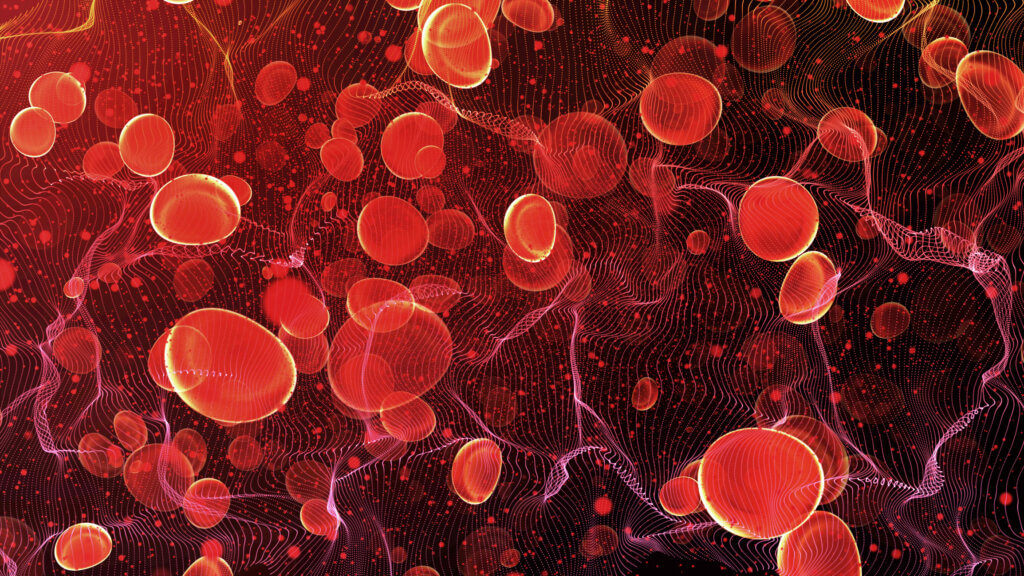- Hematologic malignancies like polycythemia vera and essential thrombocythemia involve overproduction of red blood cells and platelets, which can lead to complications such as blood clots and cardiovascular issues.
- These chronic diseases can often be managed with treatments like therapeutic phlebotomy, baby aspirin, and drugs targeting specific genetic mutations, such as JAK2.
- Ongoing research aims to develop new treatments to improve patient outcomes and prevent the progression of more severe conditions, such as myelofibrosis or leukemia.

While hematological cancers like leukemia, lymphoma, and multiple myeloma involve white blood cells, other, rarer hematologic malignancies affect red blood cells and platelets. These include polycythemia vera, in which the bone marrow produces too many red blood cells, and essential thrombocythemia, in which platelets levels are abnormally high. Both are chronic diseases that can usually be controlled with proper treatment.
Polycythemia vera
Red blood cells deliver oxygen throughout the body and carry away carbon dioxide. Too high a concentration of them can cause the blood to thicken and flow more slowly, which can lead to a variety of problems.
Polycythemia vera is diagnosed in 2.3 people per 100,000 every year. It often doesn’t produce symptoms in its early stages and is diagnosed, in many cases, when a routine blood test shows highly elevated levels of red blood cells and hemoglobin (the iron-rich protein in red blood cells that binds to oxygen and carbon dioxide). When symptoms do occur, they can include headaches, dizziness, a painful condition in the fingers and toes known as erythromelalgia, itching, and fatigue. If untreated, it can lead to cardiovascular complications such as blood clots, strokes, or heart attacks.
The disease is most common in people between ages 50 and 75. Those with a family history of the disease may be at increased risk, but it isn’t closely tied to an inherited genetic mutation. Scientists have found that more than 90% of patients have a certain mutation in the JAK2 gene, but what causes the mutation is still unknown
Treatment is linked to risk factors for complications: patients are designated as being at low or high risk. Patients who are younger and have not had a prior blood clot are often treated with therapeutic phlebotomy (blood drawing) and baby aspirin. Some patients may require treatments to keep their hemoglobin counts below a certain level to prevent hyperviscosity, a thickening of the blood that can cause clotting problems.
Newer drugs for polycythemia vera include ropeginterferon, which blocks signals that cause cancer cells to multiply, and ruxolitnib, which targets the mutated gene JAK2 and is used for patients whose disease resists standard drugs.
Essential Thrombocythemia

Platelets are critical to the process of blood clotting. When a blood vessel is damaged, they congregate at the site of damage, clump together, and stop the bleeding. As with red blood cells, however, an oversupply of platelets can lead to problems.
People with essential thrombocythemia – which is diagnosed in 1.2-3.0 people per 100,000 annually – often have no symptoms, but some may have symptoms similar to those of polycythemia vera. Based on their age and other factors, patients are designated as being at low, medium, or high risk from the disease. Patients who are over age 60 and have had a prior blood clot are considered at high risk. Younger patients, those without a prior blood clot, and without a JAK2 mutation are considered at low risk.
Patients with low-risk essential thrombocythemia often do not require treatment or may be advised to take a baby aspirin to lower the risk of unwanted clotting. Patients with higher-risk disease may be treated with hydroxyurea, a drug that lowers platelet counts.
Other drugs, some of which are approved for other conditions, may also be helpful, including interferon and anagrelide.
Research
Research is revealing the basic genetic underpinnings of these diseases, suggesting new approaches to treatment. This work is particularly important because both cancers can, in rare cases progress to myelofibrosis, a cancer that causes scar tissue to form in the bone marrow, or leukemia.
Scientists including Ross Levine, MD, formerly of Dana-Farber, found that both polycythemia vera and essential thrombocythemia are driven by mutations in the JAK2 gene. Other researchers have connected the diseases to mutations in the genes MPL and CALR.
Acting on these findings, researchers have launched a clinical trial of a CALR-targeting agent in patients with essential thrombocythemia or myelofibrosis. An agent known as a hepcidin mimetic is being clinically tested in patients with polycythemia vera. It works by signaling that the body has plenty of iron, suppressing the production of red blood cells and lowering the need for frequent phlebotomies.
About the Medical Reviewer

Dr. Wadleigh received her MD from Duke University School of Medicine in 1998. She completed postgraduate training in Internal Medicine at Duke University Medical Center, followed by a fellowship in Medical Oncology and Hematology at DFCI and Brigham and Women's Hospital. In 2004, she joined DFCI as a member of the Adult Leukemia staff.

Any new treatments for mantle cell lymphoma since July 2024?